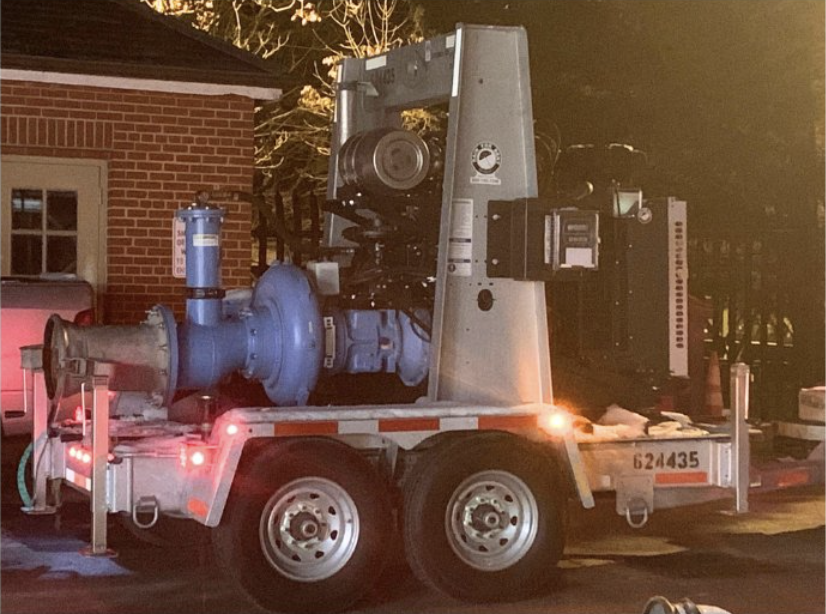‘People, pipes and pumps’: How Richmond is getting its water system back online

On the third day of Richmond’s water crisis, Department of Public Utilities Director April Bingham detailed what the city is focusing on as it races to get its water system back up and running ahead of another potential snowfall this Friday.
“It’s people, pipes and pumps,” said Bingham. “That’s what we need to operate the plant.”
With utilities workers pulling 12-hour rotating shifts and additional contractors onsite at the Douglasdale Road water treatment plant, the people base appears to be covered. And despite freezing temperatures over the past few days, the pipes also seem to be holding as officials flush the water distribution system to minimize the likelihood of breaks when water pressure returns.
What’s been much more complicated is the pumps. The Douglasdale Road plant is actually two plants combined, the older of which was constructed in 1924. Each plant contains four pumps, for a total of eight, that are responsible for pushing treated water into the distribution system. All were submerged in the Monday morning flooding.
Exactly what went wrong after the 6:50 a.m. power outage at the plant on Monday remains unclear. Officials have indicated one the plant’s backup power systems — known as an uninterruptible power supply, or UPS — failed, leading valves that should have opened to remain closed and producing extensive flooding that swamped critical equipment. But the picture remains hazy, and both the state and Richmond Mayor Danny Avula have said they will conduct detailed investigations of what went wrong once the city gets out of crisis mode.
“As soon as we get out of the emergency response phase, as soon as we get out of our first priority to restore water to people in the region, we will absolutely do a thorough after-action report to make sure that we fully diagnosed where the system failed, why it happened, what investments we need to make and what we can do to prevent that from happening in the future,” Avula said Wednesday morning.
In the meantime, much of the emergency response has focused on restoring the pumps, as well as the 22 filters that the plant uses to treat water for human consumption.
The road has been bumpy. On Monday night, Avula said Wednesday, “we’d get water moving and then a pump would go out.” Tuesday morning saw one pump working and another operational but not in service. Then an afternoon electrical panel failure “caused us to turn off pumps and pipes and filters until we could stabilize the system and restart it again,” said Bingham.
A turning point came early on Wednesday. At his 9:30 a.m. press conference, Avula said two of the eight pumps are “actively” working, with others ready to go into operation once water pressure in the system reaches a certain point.
“We require a certain amount of water and pressure to be in the reservoir and in our holding basin to actually be able to effectively use all of those pumps,” Avula said. “That’s what we are waiting for. … When we reach that pressure threshold, we’ll turn on the other pumps, and that’ll put more water into the system.”
An additional support came in the form of two “bypass” pumps owned by contractors that were delivered to the site around 2 a.m. Wednesday morning to push filtered water into the facility’s northern basin, where it can then be routed to the reservoir. City communications have said that by boosting water pressure at the site, the bypass pumps will help additional filters and more of the plant’s permanent pumps come online.
“We don’t own them. We’re contracting them currently,” Avula said. “Do we plan to purchase them in the future? I think that'll absolutely be a part of our after action analysis. I think job number one is to get our pumps up and running and stabilize and then decide.”
City officials appeared optimistic Wednesday that the system could see water pressure restored by later in the afternoon. And while they had made similar statements Tuesday that didn’t pan out, on Wednesday they offered more numbers to support the view that conditions are improving.
“We have over 45 million gallons a day, MGD, of water that is pumping out into distribution and that is actively filling up our reservoir,” Avula said at his morning press conference. “When I left around 11:30 [the night before], we were at about 9 MGD. So we’ve made some really significant progress over the last eight hours or so.”
By 4 p.m. Wednesday, the mayor said five of the pumps and 15 of the filters were operational, and distribution had risen to 69.6 MGD.
Water heights in the Byrd Park Reservoir, the city’s primary holding site for treated water, are also being watched as a key benchmark of restoration. The reservoir typically has a water height of 18 feet, Avula said, and as of Wednesday had refilled to 7 feet.
“We will feel much better when the reservoir fills to a little bit over 10 feet,” he said.
As water pressure returns, Avula asked Richmonders to continue to conserve water in order to help the system stabilize and be aware that water flowing out of faucets may contain sediment.
“The water will look rusty, it may look dirty,” he said. “That’s all just natural. Know to expect that. It doesn’t mean the water is bad. It means that it’s just picking up stuff in the system that needs to get flushed out and that will clear up over time.”
The city’s boil water advisory also remains in effect, and Avula said it was unlikely it would be lifted before Friday because of state testing requirements.
This story was updated with new data provided at 4 p.m.






